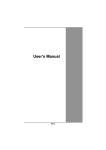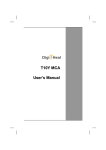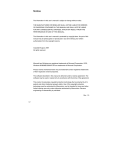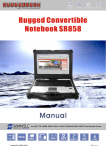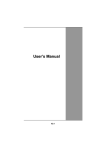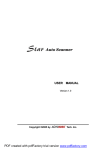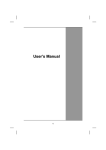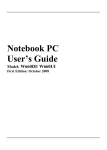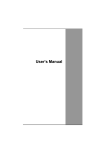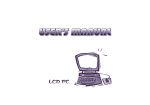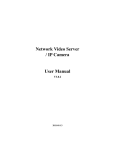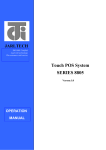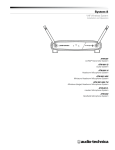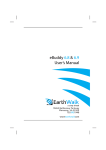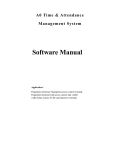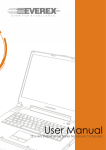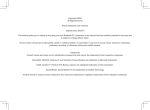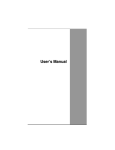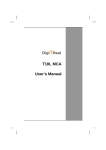Download User`s Manual
Transcript
User’s Manual Table Of Contents CHAPTER 1 GETTING STARTED 1 Getting Started ................................................................................... 2 Inventory ............................................................................................. 3 Safety and Maintenance .................................................................... 4 Checklists ........................................................................................... 5 Features .............................................................................................. 6 Where to Look For Information......................................................... 6 Quick Start .......................................................................................... 7 Loading Windows .............................................................................. 8 Adjusting the Volume and Brightness............................................. 9 Turning off Your Computer ............................................................. 10 CHAPTER 2 GETTING STARTED 11 Hardware and Software ................................................................... 12 Front View ......................................................................................... 13 Right View ......................................................................................... 14 Top View............................................................................................ 15 Bottom View...................................................................................... 16 Power Indicators .............................................................................. 17 Front View buttons........................................................................... 18 Function Keys .................................................................................. 19 Touch Pen ......................................................................................... 20 Connecting the Floppy Disk Drive ................................................. 20 Disk Drives........................................................................................ 20 The CD-ROM, DVD-ROM, or Combo Drive..................................... 21 Connecting the Printer .................................................................... 21 The PCMCIA Card Slot..................................................................... 21 CF (Compact Flash) Card Slot ........................................................ 22 Memory.............................................................................................. 22 Communication Components ......................................................... 25 CHAPTER 3 MAKING CONNECTIONS 27 Making Connections ........................................................................ 28 Right Side Connectors .................................................................... 28 ii Top Side Connectors ....................................................................... 30 CHAPTER 4 SYSTEM SOFTWARE 33 System Software .............................................................................. 34 System Recovery ............................................................................. 34 CHAPTER 5 POWER MANAGEMENT AND USING SOFTWARE 37 Power Management ......................................................................... 38 When to Replace the Battery .......................................................... 40 Heat Considerations ........................................................................ 40 Using Software ................................................................................. 41 APPENDIX A STATEMENTS 43 Statements ........................................................................................ 44 European Notice............................................................................... 46 Safety CAUTION ............................................................................... 46 Canadian Department of Communications ................................... 47 Battery Disposal............................................................................... 48 CAUTION FOR ADAPTER................................................................ 48 BATTERY CAUTION......................................................................... 48 iii Chapter 1 Introduction Chapter 1 — Introduction Getting Started Congratulations on your purchase of a Tablet PC. The Tablet PC is a fully functional PC with built-in LAN, and wireless Connectivity. With your Tablet PC you will be able to organize and access important business and personal information. In addition, you will be able to send and receive e-mail and access the Internet. This Manual contains all the information you need to set up and use your Tablet PC. It describes all the features of the Tablet PC in an easy-to-read yet thorough manner. 2 Introduction — Inventory Inventory This Tablet PC is designed for years of productive and pleasurable computing. Use this section to keep details of your purchase. This information will be required should you need to make repairs to your Tablet PC during the warranty period. Update this section when you add new options. DATE OF PURCHASE: PLACE OF PURCHASE: DEALER'S NAME: DEALER'S ADDRESS: TELEPHONE: E-MAIL ADDRESS/WWW: CONTACT PERSON: MODEL NUMBER: SERIAL NUMBER: 3 Chapter 1 — Introduction Safety and Maintenance You can use your Tablet PC under a wide range of environmental conditions. However, to ensure long use and continued high performance, consider the following factors when setting up your Tablet PC: • Follow all warnings and instructions noted in this documentation and in the Windows Help program. • The first time you use your Tablet PC, we recommend that you carefully read the Making Connections section of this manual and initialize the battery to ensure optimum battery performance. • Unplug the Tablet PC from the power outlet before cleaning. Use a damp cloth for cleaning. Do not use aerosols, solvents, or strong detergents. • Slots and openings in the system cabinet are for ventilation purposes. Do not block or cover these openings or the system could overheat. Do not use or store the Tablet PC near a source of heat or dust. • On the base or rear panel of this Tablet PC, there is a label with information on the power requirements of this system. These requirements must be followed. If you are unsure of your local power supply, consult your dealer or local Power Company. • Do not step on or place anything on the power cord. • If you use the Tablet PC with an extension cord, ensure that the total ampere ratings of all the devices sharing the extension do not exceed the rating of the extension cord or the rating of the wall outlet. • Never push foreign objects into the Tablet PC through any of the slots or openings. Dangerous voltages are present, which could cause electric shock or fire, or damage sensitive components. 4 Introduction — Checklists Checklists After opening the package, carefully inspect the contents. If any of the items is missing or appear damaged, contact your dealer. The shipping carton should contain the following: STANDARD • A Tablet PC with a hard disk drive • A standard battery • An AC adapter with power cord • User's Manual (Install in Hard Disk) • Driver CD (Install in Hard Disk) • Hand strap OPTIONS The following items are normally optional, but some vendors may include them in the standard package. Some items may not be available in some countries, or some vendors may choose not to carry all the items. • 512MB/1GB SODIMM memory card • Rugged carrying bag • Normal capacity battery • Second battery • WLAN module • Bluetooth module • Caution: When purchasing any of the accessories listed above, purchase only those accessories that are approved for use with your Tablet PC. The above accessories are proprietary items. Your system vendor can obtain these approved accessories. If you use items that are not approved for use with this Tablet PC, you may cause your Tablet PC to malfunction, or to emit or receive electro-magnetic radiation in excess of local regulations. For nonproprietary accessories such as PC cards or printers, ensure that the accessory functions properly in your Tablet PC before making the 5 Chapter 1 — Introduction purchase. Your system vendor may be able to recommend reliable brands and models. Features Software Included Widows® XP Tablet PC Edition which includes: • Microsoft® Internet Explorer • Microsoft® Outlook Express • Microsoft® Windows Media Player High performance Processors Ultra Low Voltage Mobile Intel Dothan 1.1GMhz CPU or above FSB 400Mhz CPU High Capacity Hard Disk Drive The Tablet PC has a high capacity hard disk drive, to store your favorite programs and large multimedia files. Built-in Wireless LAN, Modem and LAN Capability A built-in 802.11a/b/g, 56k modem and 10/100/1000 Mbps Ethernet port allows you to access the Internet or a local area network (LAN). Where to Look For Information About Your Tablet PC This User’s Manual describes the key elements of your Tablet PC. New users can find a simple step-by-step orientation in the Quick Start section of this chapter. About Windows Windows Online Help, found on the Start menu, offers extensive Windows assistance. Welcome to Windows offers an online orientation for new Windows users. Find it in: Start/Programs/Accessories/System Tools. 6 Introduction — Quick Start Quick Start Turning on the Tablet PC for the First Time 1. Connect the AC adapter power cord to the AC adapter. 2. Connect the AC adapter to the DC power port on the bottom side of your Tablet PC. 3. Connect the AC adapter power cord to an AC outlet. 4. Press the power button to turn on the power. Note: The battery is not fully charged. Allow your battery to fully charge before using it (i.e., before disconnecting AC power). Calibrating the battery before use is also highly recommended. Refer to Chapter of Power Management, for further information. 7 Chapter 1 — Introduction Loading Windows The following section is for installing the Windows operating system only. If you are installing a different operating system, please check with your vendor for installation details. Your Tablet PC will begin loading Windows once you turn on the power. Wait a few seconds for Windows setup to load. The Windows setup will prompt you for the product key number, shown to the right: P ro d u c t k e y n u m b e r Note: The product key is on a sticker attached to the bottom of the Tablet PC. 1. Type your name, and, if applicable, the name of your company. 2. Read the End User's License Agreement. Click Next to accept it. 3. Enter the product key number. You can find this on the Certificate of Authenticity on a sticker attached to the Tablet PC. Click Finish. 4. The Start Wizard will prompt you to set the date, and your local time. After the Start Wizard updates your system settings, the Welcome to Windows screen will appear. You may disable this feature by clearing the check box labeled show this screen each time Windows starts. Some software comes preloaded with Windows. New users can familiarize themselves with this software by selecting Programs from the start menu, then clicking on programs to run them. 8 Introduction — Adjusting the Volume Adjusting the Volume You can adjust the volume with hot key: • Fn + Arrow Up: volume up • Fn + Arrow Down: volume down Alternatively, you can adjust the volume with the Windows volume control applet located on the taskbar. Adjusting the Brightness Use the following hot key combinations to adjust the LCD panel brightness: • Fn + Arrow Left: decreases the brightness • Fn + Arrow Right: increases the brightness 9 Chapter 1 — Introduction Turning off Your Tablet PC Turning off the Tablet PC Tablet PC properly is important to maintaining your Tablet PC. 1. On the Start menu, click Shut Down. 2. Click the radio button next to Shut Down in the Shut Down Windows screen, and then click OK. If you are going to be away from the Tablet PC for a short period, there are ways of conserving power without shutting down the system. Warning: Shutting off the Tablet PC improperly may result in data loss. 10 Chapter 2 Getting Started Chapter 2 — Getting Started Hardware and Software This chapter introduces the different components and controls of your Tablet PC, including the hardware components, the software, and the audio and video systems. Getting Started Before you begin using your Tablet PC, read this chapter to familiarize yourself with the main components installed in the system. 12 Getting Started — Front View Front View 1. Speakers 8. Tab button 2. Security button 9. Up/Down (Volume Control) & Left/Right (Brightness Control) buttons 3. Quick Launch Button 4. Function button 5. Backspace button 6. Numeric / Multi-fun. buttons 7. Enter button 10. Internal microphone 11. Status indicator 12. LCD panel 13. Power button 13 12 Fn 7 8 9 4 5 6 1 2 3 Ta b 0 1 2 3 4 5 6 7 11 8 10 9 13 Chapter 2 — Getting Started Right View 1. Microphone-in jack 2. Audio-out jack 3. CF card slot 4. USB port 5. RJ-11 jack 6. DC-adaptor port 7. Multi IO connector 8. RS232 serial port 1 8 2 7 3 6 4 5 14 Getting Started — Top View Top View 1. RJ-45 jack 2. PC card slot 3. Mini USB port 4. Pen tether hole 1 2 3 15 4 Chapter 2 — Getting Started Bottom View 1. Back hand strap foot screw 2. Reset button 3. RF On/Off button 4. Touch pen holder 16 Getting Started — Power Indicators Power Indicators The power indicators show which power source the system is using. They also show battery status and low battery power alerts. The power indicators remain active and viewable even when the LCD panel is closed. Icon Light Description Blue Wireless LAN/Bluetooth is in use Green Tablet PC is reading from, or writing to the built-in hard disk. Green Battery fully charged Orange Battery charging Flashing Battery power critically low Red Blue Flashing Blue Power is on and the battery is in use Power is in suspend mode 17 Chapter 2 — Getting Started Front View Buttons The seven hot keys are unique features of your Tablet PC. The function as follows: Icon Function Power Button The Power button turns system on and goes into standby automatically. If the unit has been sitting unused for a while. Press momentarily to turn on the system or to exit from standby. Press and hold for at least 3-4 seconds to turn off the system. These settings can be changed. Security Button Similar function as pressing Ctrl+Alt+Delete on a standard keyboard. Function Button Access to secondary operation of some buttons on the front bezel (shown in the illustration above),user set up. Backspace Button Same function as on a standard keyboard Quick-Launch Button Can be assigned to launch specific windows base program as a quick-launcher Enter Button Same function as on a standard keyboard. Tab Button Under Normal Input Mode: Same function as on a standard keyboard. Under Calculation Mode: Role as “Period”(.). 18 Getting Started — Function Keys UP/Down Button Same function as on a standard keyboard. Left/Right Button Under Normal Mode: Same function as on a standard keyboard. Under Calculation Mode: Arrow Left / Arrow Right : - / + Numeric Key Same function as on a standard keyboard. Function Keys Hold the Fn key while pressing the function key. Function key Description Fn + Down Volume down Fn + Up Volume up Fn + Left Brightness Decrease Fn + Right Brightness Increase Fn + 0 Switch Touch Screen / Digitizer input mode Fn + 7 Screen Rotate From Portrait (Screen Rotate 90 degree) to Landscape(Default) Mode or vice versa Fn + 9 Escape same as standard Keyboard Fn + 4 Trigger keypad LED backlight Fn + 5 Switch calculation/normal input mode 19 Chapter 2 — Getting Started Touch pen The button located directly on the touch pen is the same in function as right buttons on the mouse. Clicking button makes selections to perform a variety of other functions depending on the software. To select an object, first move the pointer over the object you want. Connecting the Floppy Disk Drive Your Tablet PC comes with a USB port 1.44 MB floppy disk drive (FDD is optional). The FDD is “hot pluggable,” so you do not have to power down the Tablet PC to connect it. Floppy Disk Drive USB connector Disk Drives Your Tablet PC comes with several components for reading and writing (recording) information. Floppy Disk Drive The floppy disk drive provides a convenient way of storing and transferring small files. The disk drive uses standard 3.5-inch, 1.44 MB disks. To use the disk drive, insert a disk (label side up) into the drive slot and slide it all the way in. To eject the disk from the drive, press the eject button. When the Tablet PC is reading from or writing to a disk, the disk indicator light will flash. Do not try to eject the disk when this light is active or you may lose data. 20 Getting Started — The CD-ROM, DVD-ROM, or Combo Drive Hard Disk Drive The hard disk provides high-capacity storage and fast access. Windows and most programs are stored here. Your Tablet PC identifies the hard disk drive as drive C. The CD-ROM, DVD-ROM, or Combo Drive Your Tablet PC comes with the CD-ROM, DVD-ROM, or Combo drive (It is optional). The CD-ROM drive is a read-only drive. It cannot be used to write data to a recordable CD. The CD-ROM drive can read data from CDs, including audio or video CDs. The CD-RW can perform these same functions, as well as record information to writeable CD's. The DVD drive can read both DVDs and CDs. Your Tablet PC identifies the drive with the letter following the hard drive letter. If your hard drive is D, then the CDROM drive will be E. Connecting the Printer To connect a printer to your Tablet PC via the USB port, use the supplied USB to printer adapter cable. Note: Before use, you must install the driver for the adapter cable. The PC Card Slot Your Tablet PC includes card slot which supports PCMCIA Type II, 32-bit CardBus, 21 Chapter 2 — Getting Started Note: Please read the instructions included with individual PC cards. Some cards may be inserted with power on, while others require that the Tablet PC be turned off. CF (Compact Flash) Card Slot The CF card slot can be used as an interface between your Tablet PC and a variety of devices, Insert a CF card in the CF Card Slot as shown below untill it snaps into place. Press the eject button to release the card. Memory Adding memory allows the Tablet PC to operate faster, handle more tasks simultaneously, and work more smoothly with large files. Users who increase memory demands - by adding additional programs, for example may notice a slowdown in operating speed, and wish to increase memory. The Tablet PC includes a memory card slot for adding additional memory. Note: Use only 1-inch DDR II SODIMM modules. Calculate memory size by adding the size of the memory module to the existing built-in memory. For example: 512 MB (module) + 256 MB (built-in memory) = 768 MB Total 22 Getting Started — Memory Replacing a Memory Card Warning: Memory modules can be easily damaged by static electricity. Leave the module inside its static-proof bag until it is ready for installation. Removing a Memory Card Turn off the Tablet PC and disconnect the AC adapter. Turn the Tablet PC upside down and lay it on a flat surface. Carefully remove the two RAM compartment cover screws and remove the RAM compartment cover. Carefully remove the Bluetooth module screws ,unplug buuetooh harness then remove bluetooth module . Gently pull tabbed latched in the direction of the arrows (1). The card will pop up slightly. Pull upwards on the card and then slide the card out (2). 23 Chapter 2 — Getting Started Inserting a Memory Card 1. Hold the memory card by its edges with the edge-connector side towards the slot. 2. Hold the card at a shallow angle (about 25 degrees) and insert the edge connector into the connector slot (3). The “gold teeth” of the edge connector should no longer be visible when the card is fully inserted. 3. Press the card downwards so that it is flat inside the compartment (4). You may hear an audible click as the latches of the connector lock the card in place. 4. Replace bluetooth module, attach harness and secure it with screws. 5. Replace the RAM compartment cover and secure it with the two screws. Your Tablet PC will automatically detect the change in RAM capacity when it restarts. 24 Getting Started — Communication Components Communication Components This system includes built-in Fax/Modem. Fax/Modem A phone jack on the top side of the Tablet PC allows you to connect to the Internet to send and receive data. When used with fax software, it can be used as a fax. When using this function, first plug the phone cord into the jack. Anti-electromagnetic wave clip To eliminate electromagnetic waves, it is strongly recommended that you thread the USB cable or phone cord through the clip provided as shown below when using USB peripherals, audio-out jack or connecting to a phone line. Attention: When using the data communications function, please do not plug the phone cord into the ISDN or PBX jack to avoid an electrical surge that will cause the MDC module to burn. 25 Chapter 3 Making Connections Chapter 3 — Making Connections Making Connections Your Tablet PC is equipped with a full array of ports and connectors, including standard input/output (I/O) ports for quickly and easily adding peripheral devices such as printers, keyboards, and mice. Refer to documentation included with individual devices for details on connecting these devices to your Tablet PC. Right Side Connectors 1 8 2 7 3 6 4 5 1. Microphone-in Jack Connect a microphone this jack to record audio. 2. Audio-out Jack Connect a stereo headset or external speakers to this jack to listen to multimedia. 28 Making Connections — 3.CF Card Slot Accepts devices that are designed to use CF card interface. Insert a CF card in the CF Card Slot as shown above until it snaps into place. Press the eject button to release the card. 4. USB (Universal Serial Bus) Ports The Universal Serial Bus (USB) is the latest standard for attaching monitors, input devices, scanners, and other devices to a PC. USB devices can be chained together on a single cable. 5. Fax/Modem RJ-11 Jack The fax/modem can transmit data using the 56 Kbps V.90 protocol, and send and receive faxes at 14.4 Kbps. In some countries, local regulations may not permit the use of the fax/modem designed for this system. In this case, you may use a PCMCIA modem. 6. DC-in Jack Connect the DC power cable from the AC adapter to this jack. 7. Multi IO connector The Connector is reserved for specific purpose which is used to connect to customer’s device. 8. Standard D-Sub RS232 Port 29 Chapter 3 — Making Connections Top Side Connectors 1 2 3 4 1. LAN RJ-45 Jack With the built-in Ethernet LAN combo, you can make LAN connections without installing PC cards. Connection speed is 10/100/1000 Mbps. When using the LAN function, wrap your LAN cable around the EMI ferrite suppression box to inhibit electromagnetic interference. Warning: Plug your modem into an analog telephone jack only. Most homes use analog lines. Do not use digital lines, such as the PBX and ISDN systems found in many offices. Digital lines may damage your modem. 2. PC Card Slot (PCMCIA) Insert a PC Card (PCMCIA) card in the PC Card Slot as shown above until it snaps into place. Press the eject button to release the card. 3. Mini USB port The Universal Serial Bus (USB) is the latest standard for attaching monitors, input devices, scanners, and other devices to a PC. USB devices can be chained together on a single cable. This mini-USB port can only play as host role. 30 Chapter 4 System Software Chapter 4 — System Software System Software Software List Operating System Your hard drive already contains all the software you need to operate the Tablet PC. Audio and Video Drivers These utility programs and drivers are included for the PC Card drive, the sound system, and the graphics sub-system. System Recovery (Option: depends on customer’s configuration) Before you start Your system includes Phoenix Recovery System in original hard disk. Follow the steps in the appropriate section below to recover the operating system and the system software. • The factory has pre-partitioned your system's hard disk, so you may directly install the system software; however, if you change a new hard disk, you must first partition it. • If you reinstall your operating system, all of the data originally on the hard disk will be overwritten. Before reinstalling the operating system, carefully backup any important data. Caution: When you re-install operating system by Recovery CD for Windows, we STRONGLY recommend connecting the AC adapter( do NOT use battery alone )to avoid warning message. 34 System Software — System Software Recovering Windows and Original Software (Instant Recover – Option: depends on customer’s configuration) If your Windows operating system is lost or damaged, use the Instant Recovery System Software. Instant Recovery Software No need to locate a recovery CD to restore your software settings, it is already pre-installed on your notebook hard drive. Simply follow the steps below and restore your notebook to the original factory settings. How to Access Your Instant Recovery Software 1. Turn your computer on and press Fn +4 when booting logo appears. 2. Click Protect/Recover on left hand menu. 3. Click Phoenix FirstWare Recover Pro. 4. System restarts and will take 15 seconds until the next step is displayed. 5. From Phoenix FirstWare Recover Pro Quick Start, click Pick Backup Point. 6. From Recover Pro, Factory Restore Point is the default selection. Click Restore. 7. From the Recover Pro prompt, click Yes. 8. FirstWare Recover Pro will load. 9. Click Recover Entire Drive. 10. Prompt appears, click Yes. 11. Recovery begins. 35 Chapter 5 Power Management and Using Software Chapter 5 — Power Management Power Management Checking the Battery Level You can check the remaining battery power in the Windows® battery status indicator located at the lower right-hand corner of the task tray. The Battery Status icon only appears in the task tray while the unit is running on the battery power but not while the unit is running off an external power source through the AC adaptor. Battery Power Indicator EnterMonitoring Battery Power There are two ways to monitor how much power the battery has left. 1. Click Start / Settings / Control Panel / Power Options then click Power Meter. 2. Moving the cursor to the battery icon on the taskbar is the simplest way to check on battery power status. If you do not see the battery icon, enable it in Start / Settings / Control Panel / Power Options. Choose the Advanced tab and click “Always show icon on the taskbar.” Low Battery Alarms How your Tablet PC responds to a low battery condition is set under Start / Settings / Control Panel / Power Options / Alarms. 38 Power Management — Power Management Two different power alarms can be enabled or disabled: the Low Battery Alarm, and the Critical Battery Alarm. Warning: When battery power is low, the battery indicator will flash red, and the alarm will display a warning on your screen. Take immediate action, such as saving files or connecting to the AC adapter, or data may be lost. Battery Charging When you use the AC adapter to connect your Tablet PC to a power outlet, the internal battery will automatically begin to recharge. While the battery is charging, the Battery Charge icon on the Indicator panel will be active after 6~12 seconds. When the battery is fully charged, the Battery Charge icon will turn off. If your Tablet PC is turned off, a fully discharged battery will take about 3 hours to recharge. If your Tablet PC is turned on and is not in suspend mode, it twill take about 4~5 hours to recharge the battery. Refer to the following table: Charging System On (Under Screen Saver Mode) System Off (suspend to RAM) 4~5 hours ~4 hours Note: A fully charged Li-Ion battery can run the Tablet PC for approximately 6.0 hours. 39 Chapter 5 — Power Management When to Replace the Battery Over time, the battery's capacity gradually decreases. We recommend that you replace your battery when you notice that it begins to store significantly less charge. Changing the Battery Change the main battery pack as follows: 1. Turn off the Tablet PC. 2. To replace the Battery remove the screw and the Battery Bay Cover shown right 3. Make sure the replacement battery is properly orientated. Then insert the battery into the battery compartment. Check that the latch locks back into position. Heat Considerations The Tablet PC processor has been specially designed to consume little power, and generates very little heat. However, working in a hot environment, or working for long periods may raise the temperature. If the temperature continues to rise, processor activity will be reduced. You may notice a slight loss of performance when this happens. 40 Power Management — Using Software Using Software Digitizer Calibration The touch screen is a thin membrane on the top of the LCD display that responds to mechanical pressure on the screen’s surface. The cursor on the screen is controlled using the stylus. If you notice the stylus tip touchpoint not matching up with the cursor, you can recalibrate the touch screen. Calibrating the Digitizer 1. Click the Windows® Start button > Control Panel > Switch to Classic View > Tablet and Pen Settings. Under the Setting tab, click Calibrate and follow the on-screen instructions shown below. 41 Chapter 5 — Power Management 2. Click the stylus in the middle of the crosshairs. The wheel moves to another location on-screen. 3. Repeat the exercise as above several times until the screen returns to the Calibration Applet 4. Click OK, The recalibration tales place immediately upon exciting the application. No need to restart the Tablet PC. Calibrating the Touch Screen 1. Click the Windows® Start button > Control Panel > Switch to Classic View > TouchSet Utility Settings. Under the calibration tab, click Calibrate and follow the on-screen instructions shown below. 2. Click the stylus in the middle of the crosshairs. The wheel moves to another location on-screen. 3. Repeat the exercise as above several times until the screen returns to the Calibration Applet 4. Click OK, The recalibration tales place immediately upon exciting the application. No need to restart the Tablet PC. Screen Rotation To rotate the screen the screen form Portrait to Landscape mode or vice versa, press the Fn+7 on the front of the Tablet PC. Please refer chapter 2 in this user’s manual. 42 Appendix A Statements Appendix A — Statements Statements Federal Communications Commission Statement This equipment has been tested and found to comply with the limits for a Class B digital device, pursuant to Part 15 of the FCC Rules. These limits are designed to provide reasonable protection against harmful interference in a residential installation. This equipment generates, uses, and can radiate radio frequency energy and, if not installed and used in accordance with the instructions, may cause harmful interference to radio communications. However, there is no guarantee that interference will not occur in a particular installation. If this equipment does cause harmful interference to radio or television reception, which can be determined by turning the equipment off and on, the user is encouraged to try to correct the interference by one or more of the following measures: 1. Reorient or relocate the receiving antenna. 2. Increase the separation between the equipment and the receiver. 3. Connect the equipment into an outlet on a circuit different from that to which the receiver is connected. 4. Consult the dealer or an experienced radio/TV technician for help. Shielded interconnect cables and shielded AC power cable must be employed with this equipment to insure compliance with the pertinent RF emission limits governing this device. Changes or modifications not expressly approved by the system's manufacturer could void the user's authority to operate the equipment. Declaration of Conformity This device complies with part 15 of the FCC rules. Operation is subject to the following conditions: • • This device may not cause harmful interference This device must accept any interference received, including interference that may cause undesired operation. According to FCC 15.407(e), the device is intended to operate in the frequency band of 5.15GHz to 5.25GHz under all conditions of normal operation. Normal operation of this device is restricted to indoor used environment only 44 Appendix A — Statements About The Modem This equipment complies with Part 68 of FCC rules. On the bottom of this equipment is a label that contains, among other information, the FCC registration number and ringer equivalence number (REN) for this equipment. If requested, this information must be provided to the telephone company. The modem jack of this equipment complies with Sub-part F of Part 68 of FCC rules. The REN is used to determine the quantity of devices that may be connected to the telephone line. Excessive RENs on the telephone line may result in the devices not ringing in response to an incoming call. In most, but not all areas, the sum of the RENs should not exceed five (5.0). To be certain of the number of devices that may be connected to the line, as determined by the total RENs contact the telephone company to determine the maximum REN for the calling areas. If the terminal equipment causes harm to the telephone network, the telephone company will notify you in advance that temporary discontinuance of service may be required. However, if advance notice isn't practical, the telephone company will notify the customer as soon as possible. Also, you will be advised of your right to file a compliant with the FCC if you believe it necessary. The telephone company may mark changes in its facilities, equipment, operations, or procedures that could affect the operation of the equipment. If this happens, the telephone company will provide advance notice in order for you to make the necessary modifications in order to maintain uninterrupted service. If trouble is experienced with this equipment, please contact the manufacturer for repair and (or) warranty information. If the trouble is causing harm to the telephone network, the telephone company may request you remove the equipment from the network until the problem is resolved. The equipment cannot be used on public coin service provided by the telephone company. Connection to Party Line Service is subject to state tariffs. (Contact the state public utility commission, public service commission or corporation commission for information.) 45 Appendix A — Statements The Telephone Consumer Protection Act of 1991 marks it unlawful for any person to use a computer or other electronic device, including fax machines, to send any message unless such message clearly contains in a margin at the top or bottom of each transmitted page or on the first page of the transmission, the date and time it is sent and an identification of the business or other entity, or other individual sending the message and the telephone number of the sending machine or such business, other entity, or individual. (The telephone number provided may not be a 900 number or any other number for which charges exceed local or long-distance transmission charges.) To program this information, refer to the manual of the communication software. European Notice For the following equipment: Tablet PC Is herewith confirmed to comply with the requirements set out in the Council Directive on the Approximation of the Laws of the Member States relating to Electromagnetic Compatibility (89/336/EEC), Low voltage Directive (73/23/EEC) and the Amendment Directive (93/68/EEC), the procedures given in European Council Directive 99/5/EC and 89/3360EEC. The equipment was passed. The test was performed according to the following European standards: • EN 300 328 V.1.6.1 (2004-11) • EN 301 489-1 V.1.4.1 (2005-09) / EN 301 489-17 V.1.6.1 (2002) • EN 50371: 2002 • EN 60950: 2001 Safety CAUTION To reduce the risk of fire, use only No. 26 AWG or larger telecommunication line cord. 46 Appendix A — Statements IMPORTANT SAFETY INSTRUCTIONS When using your telephone equipment, basic safety precautions should always be followed to reduce the risk of fire, electric shock and injury to persons, including the following: Do not use this product near water, for example, near a bathtub, wash bowl, kitchen sink or laundry tub, in a wet basement or near a swimming pool. Avoid using a telephone (other than a cordless type) during an electrical storm. There may be a remote risk of electric shock from lightning. Do not use the telephone to report a gas leak in the vicinity of the leak. Use only the power cord and batteries indicated in this manual. Do not dispose of batteries in a fire. They may explode. Check with local codes for possible special disposal instructions. Canadian Department of Communications This class B digital apparatus meets all requirements of the Canadian Interference-causing Equipment Regulations. About the Modem The Industry Canada label identifies certified equipment. This certification means that the equipment meets certain telecommunications network protective, operational and safety requirements. The department does not guarantee the equipment will operate to the user's satisfaction. Before installing this equipment, users should ensure that it is permissible to be connected to the facilities of the local telecommunications company. The equipment must also be installed using an acceptable method of connection. In some cases, the company's inside writing associated with a single line individual service may be extended by means of a certified connector assembly (telephone extension cord). The customer should be aware that compliance with the above conditions may not prevent degradation of service in some situations. Repairs to certified equipment should be made by an authorized Canadian maintenance facility designated by the supplier. Any repairs 47 Appendix A — Statements or alterations made by the user to this equipment, or equipment malfunctions, may give the telecommunications company cause to request the user to disconnect the equipment. Users should ensure for their own protection that the electrical ground connections of the power utility, telephone lines and internal metallic water pipe system, if present, are connected together. This precaution may be particularly important in rural areas. CAUTION: Users should not attempt to make such connections themselves, but should contact the appropriate electric inspection authority, or electrician, as appropriate. "The Load Number (LN) assigned to each terminal device denotes the percentage of the total load to be connected to a telephone loop which is used by the device. To prevent overloading, the termination on a loop may consist of any combination of devise subject only to the requirement that the total of the Load Numbers of all the devices does not exceed 100." Battery Disposal THIS PRODUCT CONTAINS A LITHIUM-ION OR NICKEL-METAL HYDRIDE BATTERY. IT MUST BE DISPOSED OF PROPERLY. CONTACT LOCAL ENVIRONMENTAL AGENCIES FOR INFORMATION ON RECYCLING AND DISPOSAL PLANS IN YOUR AREA. CAUTION FOR ADAPTER THIS TABLET PC IS FOR USE WITH MODEL NO. 0335A2065 , 0335C2065. BATTERY CAUTION DANGER OF EXPLOSION IF BATTERY IS INCORRECTLY REPLACED. REPLACE ONLY WITH THE SAME OR EQUIVALENT TYPE RECOMMENDED BY THE MANUFACTURER. DISPOSE OF USED BATTERIES ACCORDING TO THE MANUFACTURER'S INSTRUCTIONS. Regulatory information / Disclaimers Installation and use of this Wireless LAN device must be in strict accordance with the instructions included in the user documentation provided with the product. Any changes or modifications (including the antennas) made to this device that are not expressly approved by the manufacturer may void the user’s authority to operate the equipment. 48 Appendix A — Statements The manufacturer is not responsible for any radio or television interference caused by unauthorized modification of this device, or the substitution of the connecting cables and equipment other than manufacturer specified. It is the responsibility of the user to correct any interference caused by such unauthorized modification, substitution or attachment. Manufacturer and its authorized resellers or distributors will assume no liability for any damage or violation of government regulations arising from failing to comply with these guidelines. IMPORTANT NOTE (CO-LOCATION) FCC RF Radiation Exposure Statement: This equipment complies with FCC RF radiation exposure limits set forth for an uncontrolled environment. This device and its antenna must not be co-located or operating in conjunction with any other antenna or transmitter. SAR Exposure This device has been tested for compliance with FCC RF Exposure (SAR) limits in typical flat configurations. In order to comply with SAR limits established in the ANSI C95.1 standards, it is recommended when using a CF card that the integrated antenna is positioned more than 1.5cm from your body or nearby persons during extended periods of operation. If the antenna is positioned less than 1.5cm from the user, it is recommended that the user limit the exposure time. WLAN “To prevent radio interference to the licensed service, this device is intended to be operated indoors and away from windows to provide maximum shielding. Equipment (or its transmit antenna) that is installed outdoors is subject to licensing.” For LPD “Operation is subject to the following two conditions: (1) this device may not cause interference, and (2) this device must accept any interference, including interference that may cause undesired operation of the device.” W/detachable antenna “To reduce potential radio interference to other users, the antenna type and its gain should be so chosen that the equivalent isotropically 49 Appendix A — Statements radiated power (EIRP) is not more than that required for successful communication.” This Class B digital apparatus complies with Canada RSS-210. Cet appareil numérique de la classe B est conforme à la norme CNR210 du Canada The abbreviation, IC, before the registration number signifies that registration was performed based on a Declaration of Conformity indicating that Industry Canada technical specifications were met. It does not imply that Industry Canada approved the equipment. (DoC) The term “IC:” before the certification/registration number only signifies that the Industry Canada technical specifications were met. 50

















































